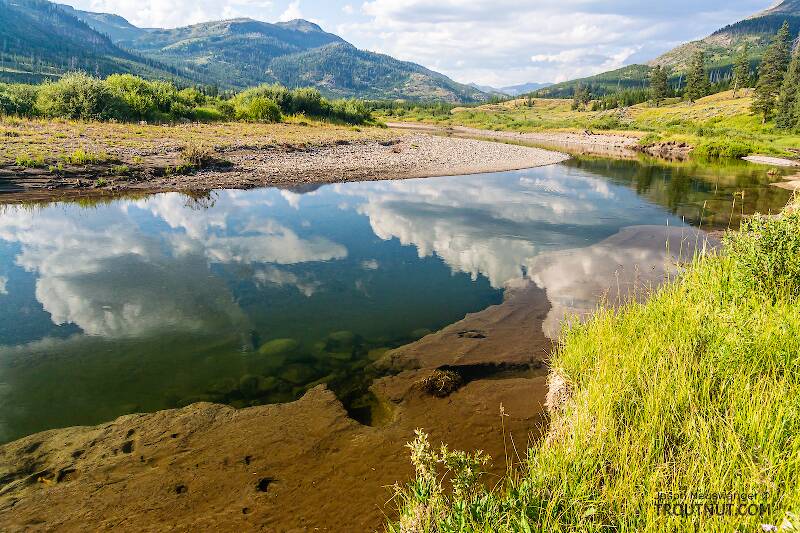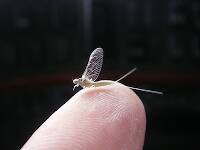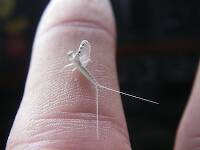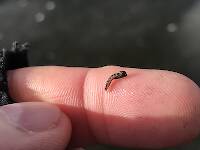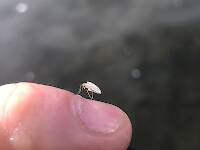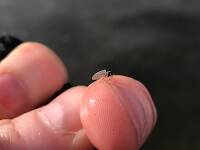
Salmonflies
Pteronarcys californica
The giant Salmonflies of the Western mountains are legendary for their proclivity to elicit consistent dry-fly action and ferocious strikes.
Featured on the forum

It's only barely visible in one of my pictures, but I confirmed under the microscope that this one has a prosternal horn and the antennae are mid-way between the eyes and front of the head capsule.
I'm calling this one Pycnopsyche, but it's a bit perplexing. It seems to key definitively to at least Couplet 8 of the Key to Genera of Limnephilidae Larvae. That narrows it down to three genera, and the case seems wrong for the other two. The case looks right for Pycnopsyche, and it fits one of the key characteristics: "Abdominal sternum II without chloride epithelium and abdominal segment IX with only single seta on each side of dorsal sclerite." However, the characteristic "metanotal sa1 sclerites not fused, although often contiguous" does not seem to fit well. Those sclerites sure look fused to me, although I can make out a thin groove in the touching halves in the anterior half under the microscope. Perhaps this is a regional variation.
The only species of Pycnopsyche documented in Washington state is Pycnopsyche guttifera, and the colors and markings around the head of this specimen seem to match very well a specimen of that species from Massachusetts on Bugguide. So I am placing it in that species for now.
Whatever species this is, I photographed another specimen of seemingly the same species from the same spot a couple months later.
I'm calling this one Pycnopsyche, but it's a bit perplexing. It seems to key definitively to at least Couplet 8 of the Key to Genera of Limnephilidae Larvae. That narrows it down to three genera, and the case seems wrong for the other two. The case looks right for Pycnopsyche, and it fits one of the key characteristics: "Abdominal sternum II without chloride epithelium and abdominal segment IX with only single seta on each side of dorsal sclerite." However, the characteristic "metanotal sa1 sclerites not fused, although often contiguous" does not seem to fit well. Those sclerites sure look fused to me, although I can make out a thin groove in the touching halves in the anterior half under the microscope. Perhaps this is a regional variation.
The only species of Pycnopsyche documented in Washington state is Pycnopsyche guttifera, and the colors and markings around the head of this specimen seem to match very well a specimen of that species from Massachusetts on Bugguide. So I am placing it in that species for now.
Whatever species this is, I photographed another specimen of seemingly the same species from the same spot a couple months later.

Troutnut is a project started in 2003 by salmonid ecologist Jason "Troutnut" Neuswanger to help anglers and
fly tyers unabashedly embrace the entomological side of the sport. Learn more about Troutnut or
support the project for an enhanced experience here.
Wbranch on Jun 28, 2008June 28th, 2008, 3:00 pm EDT
I just returned from a ten day trip to the Beaverhead and a few other SW Montana streams. I'm hoping some of the really knowlegeable bug men here can explain something to me. When I did some investigation of the nypmh life in the stream we fished most of the aquatic vegetation was full of light olive green nymphs that appeared to be Ep dorothea aka Ep infrequens for those older fly guys like me who don't keep up with the name changes.
The nymphs I collected were slender and no longer then 12 mm. They were uniformly the same color green and appeared to have gills along the abdomen. Now the query ---when the nymphs started to drift, and the duns began emerging the shucks were totally black. Do the nymphs change color, from olive green to black just prior to emergence?
By the way the fishing was very good and if I can figure out how to reduce the size of my pictures I'll post some of them here. Thanks in advance!
The nymphs I collected were slender and no longer then 12 mm. They were uniformly the same color green and appeared to have gills along the abdomen. Now the query ---when the nymphs started to drift, and the duns began emerging the shucks were totally black. Do the nymphs change color, from olive green to black just prior to emergence?
By the way the fishing was very good and if I can figure out how to reduce the size of my pictures I'll post some of them here. Thanks in advance!
Catskill fly fisher for fifty-five years.
Softhackle on Jun 29, 2008June 29th, 2008, 4:52 am EDT
Hi,
Could it be because the exoskeleton on the nymph is dark that once empty it appears black? The fly is comparatively lighter than the nymphs, meaning the internal fly is lighter,and shows through the darker covering? This is what I'm thinking, anyway.
Mark
Could it be because the exoskeleton on the nymph is dark that once empty it appears black? The fly is comparatively lighter than the nymphs, meaning the internal fly is lighter,and shows through the darker covering? This is what I'm thinking, anyway.
Mark
"I have the highest respect for the skilled wet-fly fisherman, as he has mastered an art of very great difficulty." Edward R. Hewitt
Flymphs, Soft-hackles and Spiders: http://www.troutnut.com/libstudio/FS&S/index.html
Flymphs, Soft-hackles and Spiders: http://www.troutnut.com/libstudio/FS&S/index.html
GONZO on Jun 29, 2008June 29th, 2008, 5:34 am EDT
Wbranch, can you recall whether any of the olive green nymphs you saw in the aquatic vegetation had black (or darkened) wingpads?
Konchu on Jun 30, 2008June 30th, 2008, 6:25 am EDT
Sounds like you found some Ephemerella excrucians (was inermis). I reared some of the nymphs to the spinner stage a few years ago from that area.
They do kind of change color.
They do kind of change color.
Wbranch on Jul 3, 2008July 3rd, 2008, 9:58 am EDT
I've always thought enermis was much smaller than dorothea??? Swisher and Richards "Selective Trout" indicate the size to be 5.5 mm - 7 mm or a #20 - #22 hook. The live nymphs and the empty shucks were in the 10 mm - 12 mm range. I collected more than one on the tip of my index finger and they are not olive at all (like the live nymph) but very dark - dark gray to black. I guess I'll just have to wait unti next year and collect a few live nymphs and empty shucks and post some pictures here so you guys can see the actual specimens. Thanks anyway.
Here is a pretty good representation of the browns we were catching.
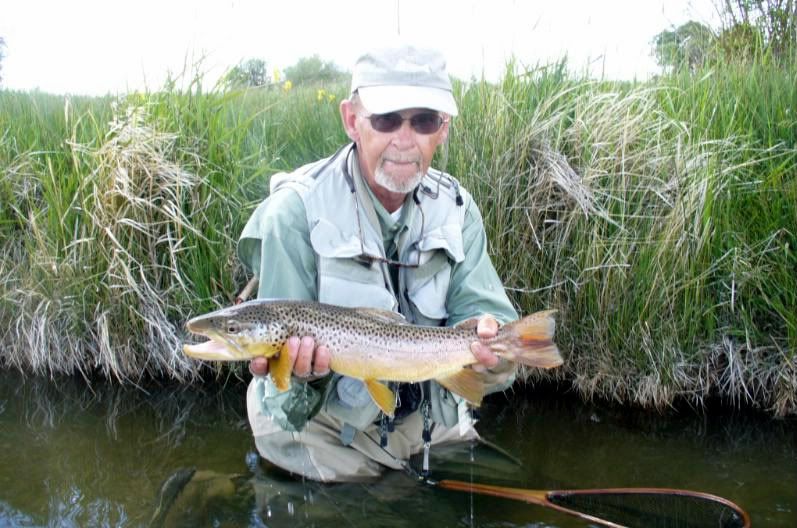
Here is a pretty good representation of the browns we were catching.

Catskill fly fisher for fifty-five years.
GONZO on Jul 3, 2008July 3rd, 2008, 10:12 am EDT
Stunning fish, Wbranch. I'd say that a trip back to the Beaverhead is essential--strictly for taxonomic clarification, you understand. At least, that would be my story, and I'd stick to it. ;)
Shawnny3 on Jul 3, 2008July 3rd, 2008, 10:56 am EDT
Holy crap, Wbranch! No wonder you had to reduce the size of the pictures before you uploaded them! What a fish!
-Shawn
-Shawn
Jewelry-Quality Artistic Salmon Flies, by Shawn Davis
www.davisflydesigns.com
www.davisflydesigns.com
Wbranch on Jul 3, 2008July 3rd, 2008, 12:59 pm EDT
Thanks guys!, yes it was a lovely male a bit more than 22". It ate a #18 PMD with medium dun CDC wings and a yellow grizzly hackle. My friend took a few other pictures that better portray the full depth of this fish and I'll post them when he sends me the file. I agree another scientific trip is necessary to capture some nymph specimens but I'm not sure that my wife will understand that I wouldn't ask to go if it wasn't for the advancement of entomological research!
Catskill fly fisher for fifty-five years.
Softhackle on Jul 4, 2008July 4th, 2008, 2:12 am EDT
Great fish! We're awaiting your next scientific excursion. It should be interesting.
Mark
Mark
"I have the highest respect for the skilled wet-fly fisherman, as he has mastered an art of very great difficulty." Edward R. Hewitt
Flymphs, Soft-hackles and Spiders: http://www.troutnut.com/libstudio/FS&S/index.html
Flymphs, Soft-hackles and Spiders: http://www.troutnut.com/libstudio/FS&S/index.html
Konchu on Jul 4, 2008July 4th, 2008, 3:04 pm EDT
inermis and infrequens (=excrucians and =dorothea infrequens) can live in the same stream, with infrequens in the higher gradient areas and inermis usually in the slower, flatter places, often in with the filamentous algae. there still are a lot of questions about the IDs of Ephemerella spp., especially in places like SW Montana, so you will just have to keep going back until all the entomologists agree on the answer. ;)
Wbranch on Jul 5, 2008July 5th, 2008, 7:27 am EDT
Konchu,
"especially in places like SW Montana, so you will just have to keep going back until all the entomologists agree on the answer. ;)"
Okay, that sounds like a fine plan to me!
The picture of the large brown was my largest fish of the trip here is a picture of the average we caught. While I didn't measure it it appears to be in the 18" - 19" range.
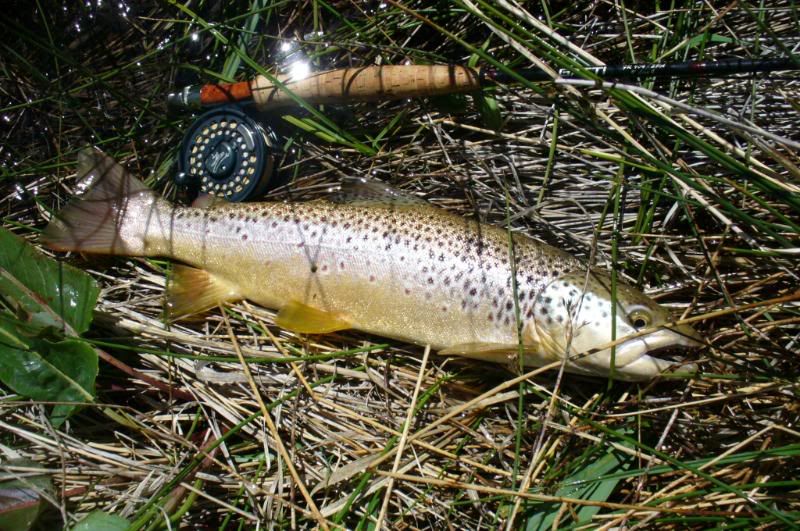
"especially in places like SW Montana, so you will just have to keep going back until all the entomologists agree on the answer. ;)"
Okay, that sounds like a fine plan to me!
The picture of the large brown was my largest fish of the trip here is a picture of the average we caught. While I didn't measure it it appears to be in the 18" - 19" range.

Catskill fly fisher for fifty-five years.
Quick Reply
Related Discussions
Topic
Replies
Last Reply
0
Jun 29, 2020
by Wiflyfisher
by Wiflyfisher
Re: So is Ep Infrequens now known as Ep Dorothea?
In the Mayfly Species Ephemerella dorothea infrequens by Wbranch
In the Mayfly Species Ephemerella dorothea infrequens by Wbranch
20
Jul 1, 2014
by Crepuscular
by Crepuscular
10
Jul 27, 2008
by Phillyfired
by Phillyfired

